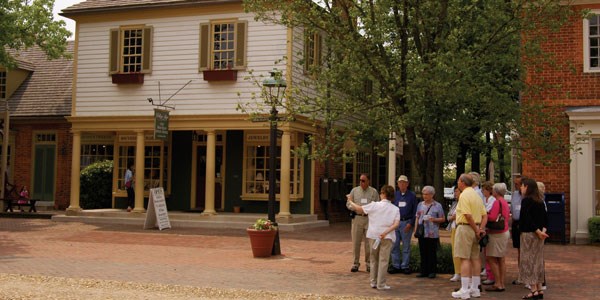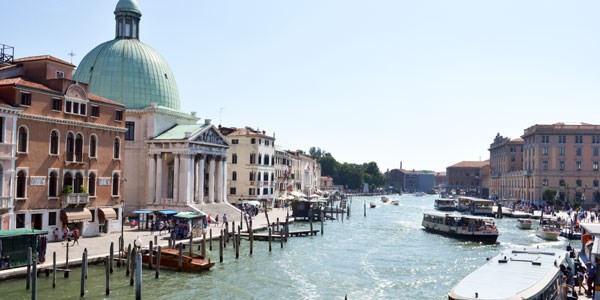10 Car-Free Destinations to Explore on Foot
Imagine a world where children do not have to look both ways before crossing the street and “traffic” is a forgotten word. The air would be cleaner, the pace of life would be slower — and exercise would be a happy requirement of daily life.
Trying to diminish air pollution and relieve road congestion, more and more cities are looking for a way to decrease their dependence on automobiles. But is it really possible to eliminate this modern wonder from mainstream activities?
Many places have accomplished this feat and are reveling in a slower pace of life. Explore our top eight car-free destinations and see why you should leave your car at home.
Cuttyhunk Island, Mass.
Found along the waters between Buzzards’ Bay and Martha’s Vineyard, Cuttyhunk Island traveled a long way to get there. Originating from rocks in the mountains of Vermont and New Hampshire that were bulldozed by glaciers, this tiny Massachusetts island welcomed early European settlers and witnessed the wrath of the mighty ocean against the fishermen and explorers who braved its surrounding waters.
Stories of shipwrecks and stout-hearted mariners may seem to conflict with the modern peace and quiet enjoyed by the island’s 50 residents, who walk, bike and drive golf carts around their island home. Visitors to Cuttyhunk delight in the quiet beaches and nature preserves that this 1½-mile-long island offers. Boaters can sail around the beautiful coast line, while fishing enthusiasts join locals in tales of the ones that got away.
Road Scholar recommends: On the Road: Cape Cod, Martha's Vineyard and Nantucket

Mackinac Island, Mich.
Through the years, Mackinac Island has been transformed through the roles of a prehistoric fishing camp, British fortress, a foothold in the American fur trade, and a Victorian vacation resort. Its rich history won this island on Lake Huron the distinction of becoming a National Historic Landmark, preserving the character and culture of a unique location in American lore.
Today, 80 percent of Mackinac’s 3.8 miles of area is designated as a state park and wildlife refuge. The year-round population of 523 residents spikes significantly in the summers as visitors are drawn to the island’s natural and historic charm. However, even in the heart of summer, Mackinac retains a slower pace of life as horse-drawn carriages and bicycles are the primary modes of transportation.
Arcosanti, Ariz.
A brilliant feat of architecture or a new consideration for ecology? The experimental town of Arcosanti, Ariz., seeks to combine urban atmosphere with the beauty and peace of nature — all on 25 acres of land preserve. The brainchild of Italian architect Paolo Soleri, the project began in 1970 and continues today, as volunteers help to build new additions to the city’s vistas.
Its mantra of self-sustainability has added to the slow growth of the community, which relies on the sales of artwork and workshop tuitions to fund new projects for growth. But perhaps the lack of urban sprawl — and vehicles — is in itself the ultimate goal of Acrosanti as it continues to develop the concept of arcology — low-impact architecture.
Road Scholar recommends: Signature City Phoenix-Scottsdale

Colonial Williamsburg
Walk down the streets of Colonial Williamsburg and you will experience America in its earliest and purest form. Homes here are not illuminated by the wonders of electricity, but instead by candlelight. Heavy layers of clothing are worn by men and women even on the hottest of days. A horse and wagon provide the primary means of transportation, as the marvel of the automobile is something that society will not see for another 200 years.
Throughout the 18th century, Williamsburg served as the hub of culture, government and learning within the Colony of Virginia. Today, visitors from around the world stroll through accurately recreated homes and public buildings and chat with interpreters who bring to life the essence of a revolutionary America.
Road Scholar recommends: Colonial Christmas at Williamsburg & the James River Plantations
Halibut Cove, Alaska
Daily life in Halibut Cove may offer a glimpse of a harbor porpoise gliding through the frigid ocean or sea otters frolicking near the shore. Rainbow trout and oysters tempt the palate, while a legion of shorebirds create a cacophony of sounds as they take flight.
Though the majority of this small island’s population is wildlife, an estimated 35 human residents also consider this roadless wild vista their home year-round. Accessible by boat or plane, Halibut Cove is located six miles southeast of Homer on the Kenai Peninsula. In addition to the natural wonders of Kachemak Bay State Park, residents — and visitors — enjoy the offerings of one gourmet restaurant, a floating espresso bar and art galleries dedicated to the works of local artisans.
Road Scholar recommends: The Best of Alaska’s National Parks: From Denali to Kenai

Fes el Bali, Morocco
The medina of Fes el Bali may very well be the largest, contiguous car-free area in the modern world. However, that doesn’t mean that this medieval city is without the hustle and bustle that fills the streets outside of its walls. An estimated 10,500 retail businesses ensure that Fes el Bali remains a commercial hotspot for the larger city of Fes. These businesses — and their resulting foot traffic — fill streets that range in width from two feet to the much rarer 16 feet.
A UNESCO World Heritage Site, the medina of Fes el Bali has remained essentially unchanged, with the exception of limited road adjustments to allow for small emergency vehicles. From ancient times until today, donkeys remain the preferred transport in this age-old city.
Road Scholar recommends: The Best of Morocco: Ancient Medinas to Modern Identity
Giethoorn, The Netherlands
In A.D. 1230, religious refugees found solace in what is now the village of Giethoorn. The peat-cutting industry that resulted from the area’s inhabitants — and generations thereafter — combined with floods to create the many ponds, lakes and canals that surround the tiny town. With so much water, there is little need for automobiles; boats and bicycles provide ample transportation.
An inspiration to poets and painters, Giethoorn continues to attract visitors with its breathtaking natural landscape, idyllic gardens and quaint farmhouses that are lined along the canals. Located in the midst of the Nature Reserve De Wieden, the variety of plant and animal species only adds to the charm and beauty of Giethoorn.
Road Scholar recommends: Art History in Belgium and Holland

Venice, Italy
One of the most romantic cities in the world, visitors flock to Venice because of its legendary mode of transportation — the gondola. Though the boats are a modern icon for the city, the composition and use of Venetian gondolas has developed through tradition. Each gondola is made of 280 individual pieces, including a heavy ornamentation in the front of the boat that exists not only for beauty but to counter balance the weight of the gondolier. By tradition, all Venetian gondolas are painted black.
In a city based on a system of 151 canals, there is little need — or room — for automobiles, and that aspect only seems to add to the unique charm of Venice. Locals traverse through the city on waterbuses and private boats, generally leaving the gondolas free for visitors.
Road Scholar recommends: Independent Venice: Art, Culture and Canals

Hydra, Greece
Named for the ancient springs that have since dried up, the island of Hydra boasts a rich history that began with early Greeks and continued on as it became a haven for wealthy ship owners during the 19th century. Today, its capital, Hydra Town, is considered a protected settlement, and the island itself is a thriving tourist destination.
Despite the flurry of activity that Hydra experiences with visitors seeking to frolic on its beaches or sail along the Aegean Sea, the pace of life on Hydra remains slow, as the only means of transportation is by donkey or horse. Catamarans and hydrofoils serve the population traveling between the Greek islands, and commercial areas are compact enough that visitors and residents are more than happy to walk and enjoy the island’s beauty.
Road Scholar recommends: Classical Greece: Islands of the Aegean by Yacht
Rottnest Island, Australia
Nearly 7,000 years ago, Rottnest Island separated from the Australian mainland, isolating a rich assortment of plant and animal species on its shores. Today, the island is a popular respite for local Australians seeking to relax upon its beaches and enjoy local entertainment.
Rottnest is home to a nature preserve and marine sanctuary, which is home to more than 400 species of fish. In an effort to protect the natural beauty and animal habitats that are part of the island, visitors to Rottnest may explore its wonders on bicycle or by a public trolley bus.
Road Scholar recommends: Great Australian Train Trek
